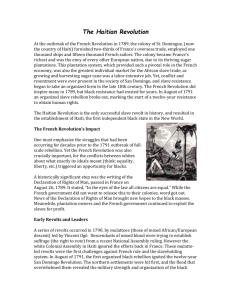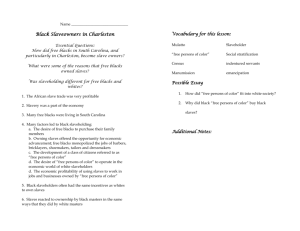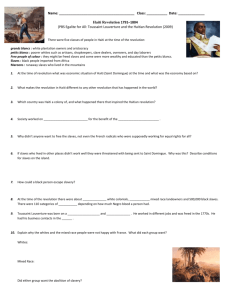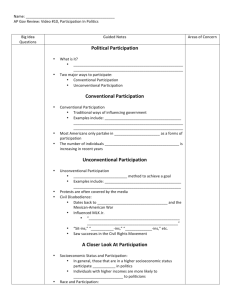Corrigan - CLAS Users
advertisement
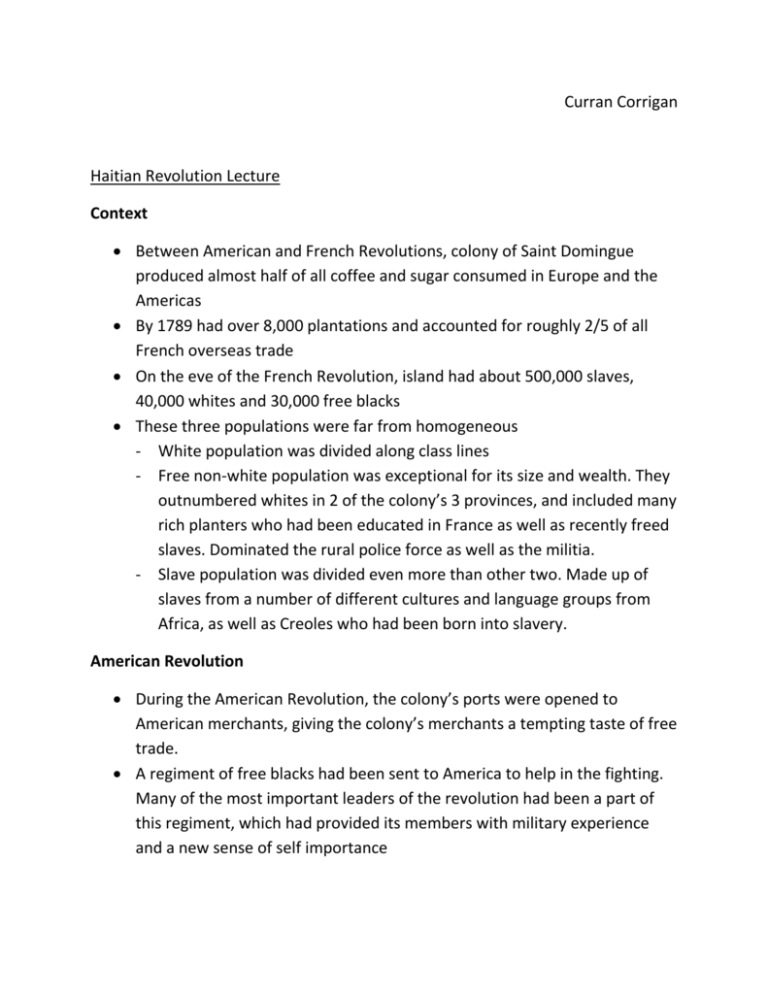
Curran Corrigan Haitian Revolution Lecture Context Between American and French Revolutions, colony of Saint Domingue produced almost half of all coffee and sugar consumed in Europe and the Americas By 1789 had over 8,000 plantations and accounted for roughly 2/5 of all French overseas trade On the eve of the French Revolution, island had about 500,000 slaves, 40,000 whites and 30,000 free blacks These three populations were far from homogeneous - White population was divided along class lines - Free non-white population was exceptional for its size and wealth. They outnumbered whites in 2 of the colony’s 3 provinces, and included many rich planters who had been educated in France as well as recently freed slaves. Dominated the rural police force as well as the militia. - Slave population was divided even more than other two. Made up of slaves from a number of different cultures and language groups from Africa, as well as Creoles who had been born into slavery. American Revolution During the American Revolution, the colony’s ports were opened to American merchants, giving the colony’s merchants a tempting taste of free trade. A regiment of free blacks had been sent to America to help in the fighting. Many of the most important leaders of the revolution had been a part of this regiment, which had provided its members with military experience and a new sense of self importance French Revolution After the storming of the Bastille and creation of the National Assembly in the summer of 1789, the island’s white elite formed elected assemblies dominated by the plantocracy. Free blacks sought to appeal for equality under the ideology of the French Revolution, but local legislative bodies maintained fiercely repressive race laws. In October 1790 an army of 300 free blacks demanding racial equality was ruthlessly destroyed and its leaders tortured to death. -The National Assembly was so shocked by the repression that it mandated political equality for all blacks born to two free parents on the island. The governor refused to acknowledge the decree, and free blacks began to gather into armed bands out of frustration. It was in this situation, with civil war between whites and free blacks brewing, that the slaves took everyone by surprise in August 1791. An enormous slave revolt erupted in the northern province of the colony, and by September more than 1,000 plantations had been looted and burned. The National Assembly in Paris was shocked into withdrawing the edict declaring political equality for free blacks, which pushed the free black factions away from allying with whites. Fighting broke out across the island, with whites, free blacks and slaves fighting against each other. In some areas, lower class whites and free blacks allied against wealthy whites, while in others hostilities were divided across race lines. As fighting grew more desperate, every side began arming larger numbers of slaves to fight for them. The situation did not stabilize until April of 1792 when French authorities granted full citizenship to all free blacks. The free blacks and whites combined forces against the slave rebels, gradually driving them further and further into the mountains. By the end of 1792 free blacks had come to dominate the island’s politics. In 1793 Britain and Spain declared war with France, and all three sides would look to the black masses for support. The French liberalized the slave regime, and when British invasion became imminent in August 1793, they abolished slavery on the island completely. British and Spanish troops would occupy regions in the south and west of the colony, and were mostly welcomed by planters as preservers of the slave regime. All three sides would recruit and arm thousands of black slaves to fight in their armies. Toussaint Louverture Toussaint Louverture was a freed slave who had owned and rented his own slaves before the revolution. In 1793 he was fighting for with rebel slaves for the Spanish. A series of victories over the course of that year led to the increase of his fame and the strength of his forces. In 1794 he switched sides and attached himself to the French cause and the ideology of emancipation. Over the next four years he fought against the British and Spanish forces and consolidated his position with the French. By 1798 the British and Spanish had been driven from the island, and all of Toussaint’s political rivals had been deported or eliminated. The last remaining obstacle to complete control of the colony was the creole leader Riguad, which controlled the southern half of the island. A fierce civil war between Toussaint and Riguad ended in 1800, with Toussaint the victor and supreme ruler of the colony. Conflict with Napoleon In 1801, shortly before Napoleon declared himself consul for life, Toussaint promulgated a constitution which flagrantly concentrated power in his own hands and made him governor for life, making the colony independent in all but name. Napoleon had originally intended to use Saint Domingue as a springboard for an invasion of the Americas. Toussaint’s declaration made it clear that until it could be put control, the colony would be of little use. Toussaint continued paying lip service to Napoleon even as he made mercantile agreements and secret non-aggression pacts with France’s enemies. He never took the step of declaring independence, but had antagonized Napoleon to the point that in 1802 an invasion force was dispatched to reassume control of the island. War of Independence The invasion force that arrived in February of 1802 quickly won control of the island’s ports and pushed inland. Toussaint surrendered in April of that year and was allowed to retire to his plantation. Within a month, however, he was arrested on charges of plotting rebellion and deported to France, where he died in 1803. July of 1802 brought a serious change in the fortunes of the French when word spread that Napoleon intended to reinstate slavery on the island. Resistance to French forces grew as many of Toussaint’s old generals added their support to the movement. Jean-Jacque Dessalines, one of Toussaint’s right hand men, became the leader of resistance forces. The resumption of war between Britain and France forced Napoleon to give up his dream of American conquests. British naval patrols effectively eliminated the ability of French ships to send reinforcements to the island, and in November of 1803 the remaining French troops were withdrawn. On January 1, 1804 Jean-Jacque Dessalines declared the independence of Haiti. Since 1791 more than 70,000 white soldiers and seamen had died on the island fighting to uphold the institution of slavery.
